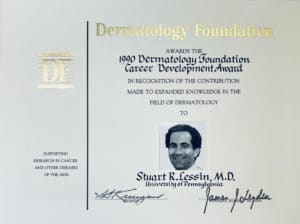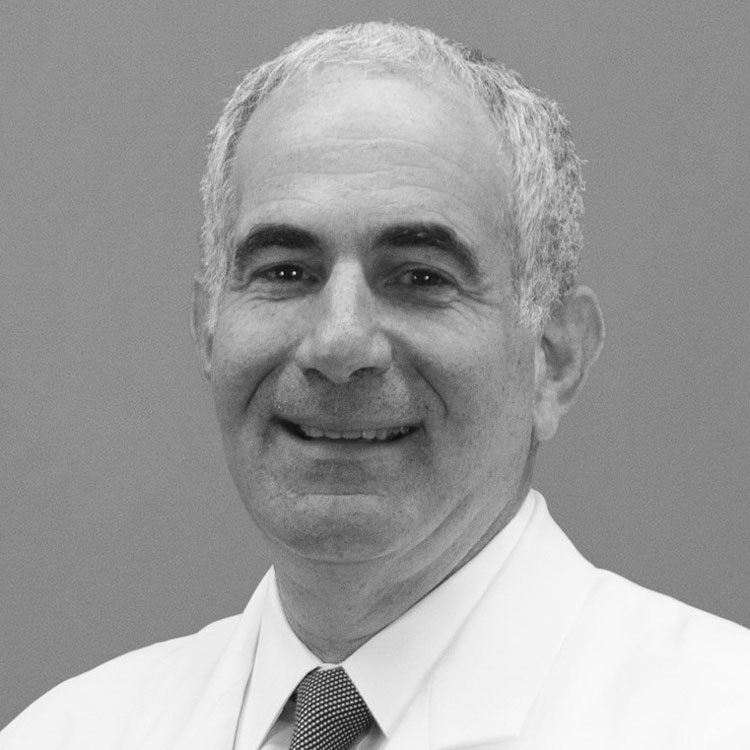When there are so many ways you can spend your time and money, and so many important causes and organizations you can support, why choose to support the Dermatology Foundation? That’s a question we posed to Dr. Stuart Lessin, a nationally-recognized dermatologist with over 30 years’ experience in laboratory and clinical research. He shared his top five.
1. The DF Launches Careers

I was able to leverage that into 19 years of federal research support through the NIH, the department of VA, and the FDA, for a very successful research career. I transitioned from laboratory research into clinical trials. So, I have run the gamut of research experience and for me, learning scientific reasoning, critical thinking, and the standards of excellence that are required to perform excellent research — has been a very gratifying experience.
2. The DF Connects a Community
When I finished my Foundation funding in 1993, and went on to more independent grants, I was asked to join the volunteer campaign of raising funds for the Dermatology Foundation through the Leaders Society.
“It provided me with professional recognition, and it also provided me with personal validation for my career choice, which is important for people in their early career.”
It was a very natural thing for me to do because I felt very connected to the DF mission, having just experienced how the funding was so helpful. I’ve been supporting the DF ever since. And I would say that the gratification of that comes from providing me with a connection to a community of like-minded individuals who believe that a strong research pathway of individuals and discoveries is critical to keeping our specialty of dermatology vibrant.
In my experience, dermatologists trained in centers with strong research programs with a large longstanding faculty, are exposed to a loyal community they feel connected to. Dermatologists trained in smaller programs and more isolated from larger resources often aren’t as connected to the bigger picture and are unfamiliar with the mission and workings of the foundation. It’s important to spread the word and show how this community of knowledge can be a resource for all dermatologists.
3. The DF Advances Medical Science
When you go back to those who founded the DF in 1964, it was a visionary group of dermatologists who realized that the specialty would benefit from a strong, sustained scientific base.
Many people don’t appreciate just how recent our history of modern American medicine is, but it’s basically only a century old. Dermatology really came into its own, as did American medicine, post-World War II. Prior to that, medicine was predominantly European-based. Most dermatology departments in American universities and medical schools were born in the 1950s and the therapeutics at the time were very limited and very crude. The sixties brought a revolution in American medicine and in dermatology. Dermatology grew up on a parallel track with American medicine and was sort of a younger sibling. The DF founders knew that dermatology had to keep up with and be a part of the scientific growth of American medicine.
“The DF founders knew that dermatology had to keep up with and be a part of the scientific growth of American medicine.”
Since 1990, the DF has supported career development awards and so has grown a generation of investigators. I’m part of that. And when you look at that body of work you can trace all of the major therapeutic advances in the last 20 or 30 years to those DF-supported investigators.
The Dermatology Foundation is the only organization that really focuses on the future to ensure that there’s a pathway of discovery and innovation that comes into the specialty.
4. The DF Gives Dermatologists a Competitive Advantage
Those founders realized that the specialty needed to compete with the other specialties of medicine in the research arena. When you look at our research funding sources, the biggest source is the National Institutes of Health. For decades, our academic centers have been built around the necessity to get federal research dollars to support not only the research projects, but the research infrastructure. With the DF providing the support it does to dermatologists early in their career, it gives them the opportunity to develop a research portfolio to be competitive for NIH dollars.
And it really is a competitive endeavor. Dermatology is in an institute with musculoskeletal diseases and rheumatology, and the three specialties compete basically for one budget. That’s why the DF is really critical because it gives dermatologists a competitive advantage in securing research funding that enables them to sustain independent research careers.
5. The DF Helps Create Lifesaving Therapeutics
If it weren’t for the Foundation, the bottom line is that there’d be less therapeutics available today. To me, the ultimate translation of research is advancing therapies for patients.
I focused on different things throughout my research career, but predominantly in the area of cutaneous lymphomas. I was able to make a few discoveries regarding molecular diagnosis and the immunology of the disease and developed therapeutic approaches. Ultimately, I led a multicenter trial for U.S. FDA approval of a topical chemotherapy in cutaneous T-cell lymphoma.
There is so much to be excited about in the research arena today. To start, look at the broad therapeutic category of biologics, the compounds that manipulate the immune system, there are monoclonal antibodies and small molecule inhibitors that have been developed by understanding the molecular level of disease pathology. It has been amazing to see how in the last 20 years, the growth of biologic interventions in psoriasis from the first generation of biologics to the second, to the third generation and how each generation improved the response rates in psoriasis, and that experience then rolled over into atopic dermatitis. And so now there’s a whole series of biologics being tested and developed for atopic dermatitis. And the advances in atopic dermatitis are being applied to another difficult to treat disease called hidradenitis suppurativa. So now there is development of biologics for that disease.
“There are many people living who would not be alive today if it weren’t for the new melanoma drugs.”
When I trained as a resident in the eighties, that was unheard of, unimaginable. I think biologics alone are impressive across various diseases. And the other close second is the development of therapeutics for metastatic melanoma that includes targeted therapy and immunotherapies. That started just ten years ago. Prior to 2011, if you had metastatic melanoma, your survival was about three to six months. And now that has at least doubled and really made an amazing impact. There are many people living who would not be alive today if it weren’t for the new melanoma drugs.
Dermatology and all the subspecialties — it’s an amazing field that you can acquire so much knowledge about. There’s so much to learn.
Stuart R. Lessin, MD, currently serves as the Medical Director of KGL Skin Study Center, a Philadelphia-based clinical research facility. He is an American Board of Dermatology certified dermatologist and a Fellow in the American Academy of Dermatology. He has over 30 years of laboratory and clinical research experience including topical drug development and testing. He was a NIH-funded laboratory investigator at the University of Pennsylvania and served as the Director of Dermatology at the Fox Chase Cancer Center in Philadelphia, Pennsylvania where he created and directed clinical care and clinical research programs.

